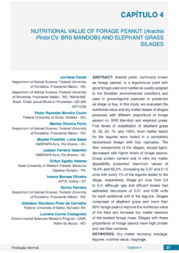Nutritional value of forage peanut (Arachis Pintoi cv. BRS Mandobi) and elephant grass silages.
Nutritional value of forage peanut (Arachis Pintoi cv. BRS Mandobi) and elephant grass silages.
Author(s): CAVALI, J.; COUTO, V. R. M.; PORTO, M. O.; SALES, M. F. L.; VALENTIM, J. F.; VALENTE, E. E.; OLIVEIRA, I. M.; FERREIRA, E.; CARVALHO, G. G. P. de; CODOGNOTO, L. C.
Summary: Arachis pintoi, commonly known as forage peanut, is a leguminous plant with good forage yield and nutritional quality adapted to the Brazilian environmental conditions and used in grass/legume pastures or preserved as silage or hay. In this study, we evaluated the nutritional value and dry matter losses of silages produced with different proportions of forage peanutcv. BRS Mandobi and elephant grass. Five levels of substitution of elephant grass (0, 25, 50, 75, and 100%, fresh matter basis) for the legume were tested in a completely randomized design with four replicates. The fiber components of the silages, except lignin, decreased with higher levels of forage peanut. Crude protein content and in vitro dry matter digestibility presented maximum values of 16.9% and 62.5%, increasing by 0.07 and 0.15 units with every 1% of the legume added to the silage, respectively. Silage pH rose from 3.8 to 5.4, although gas and effluent losses had estimated reductions of 0.01 and 0.66 units for each additional unit of the legume. Silages composed of elephant grass and more than 50% forage peanut improve the nutritional value of the feed and increase dry matter recovery of the ensiled forage mass. Silages with these proportions of forage peanut have high protein and low fiber contents.
Publication year: 2019
Types of publication: Book sections
Unit: Embrapa Acre
Keywords: Amendoim forrageiro, Arachis pintoi cv BRS Mandobi, Cacahuetes forrajeros, Capim Elefante, Estatus nutricional, Forage grasses, Forage legumes, Forage peanut, Gramínea Forrageira, Grazing, Leguminosa Forrageira, Nutritional status, Pastagem, Pastizales, Pennisetum Purpureum, Valor Nutritivo
Observation
Some of Embrapa's publications are published as ePub files. To read them, use or download one of the following free software options to your computer or mobile device. Android: Google Play Books; IOS: iBooks; Windows and Linux: Calibre.
Access other publications
Access the Agricultural Research Database (BDPA) to consult Embrapa's full library collection and records.
Visit Embrapa Bookstore to purchase books and other publications sold by Embrapa.

